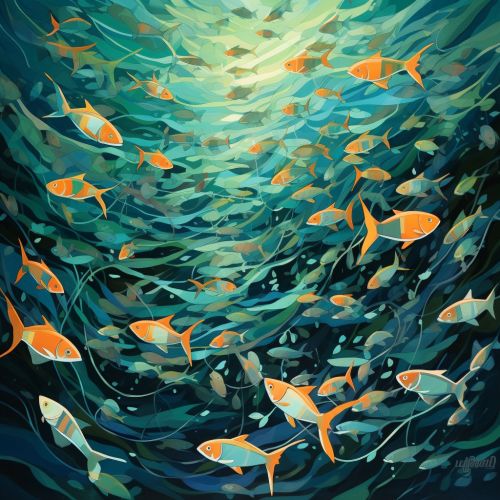School (fish)
Introduction
The term "school" is used to describe a group of fish that swim together in a coordinated manner. This phenomenon is observed in a wide variety of fish species, and it is a behavior that has fascinated scientists and laypeople alike for centuries. It is a complex social behavior that involves a high degree of coordination and communication among individual fish.
Behavior
Schooling behavior in fish is a type of social behavior that involves a group of fish moving together in a coordinated manner. This behavior is thought to provide several advantages to the individual fish, including increased protection from predators, improved foraging efficiency, and enhanced mating opportunities. The exact mechanisms that allow fish to school are still not fully understood, but it is believed that they involve a combination of visual cues, hydrodynamic interactions, and possibly other sensory modalities.
Mechanisms of Schooling
The ability of fish to form schools is thought to rely on a combination of sensory inputs and behavioral responses. The primary sensory modality used by schooling fish is vision, which allows them to monitor the positions and movements of their neighbors. However, other sensory systems may also play a role, including the lateral line system, which detects changes in water pressure and can provide information about the movements of nearby fish.
Advantages of Schooling
Schooling behavior is thought to confer several advantages to individual fish. One of the main benefits is increased protection from predators. By swimming in a large group, individual fish are less likely to be singled out by a predator. In addition, the coordinated movements of a school can confuse predators, making it more difficult for them to capture a single fish.
Disadvantages of Schooling
Despite the many advantages of schooling, there are also some potential disadvantages. One of the main drawbacks is that schooling can increase competition for food resources. In a large school, individual fish may have to compete with many others for the same food items. Additionally, the presence of a large school can attract predators, potentially increasing the risk of predation for individual fish.
Variations in Schooling Behavior
Schooling behavior can vary widely among different fish species. Some species form large, tightly coordinated schools, while others form looser aggregations. The size and structure of schools can also vary depending on environmental conditions and the availability of food resources.
Research on Schooling Behavior
Schooling behavior in fish has been the subject of extensive scientific research. This research has provided valuable insights into the mechanisms that allow fish to form schools, as well as the benefits and drawbacks of this behavior. However, many questions remain, and further research is needed to fully understand this fascinating aspect of fish behavior.
See Also


